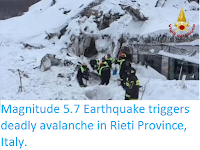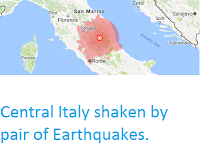Mount Etna, Italy, began erupting for the first time this year on Monday 27 February, producing fountains of lava and ash and lava flows on its flanks. The activity continued through Tuesday 28 February, and is expected to continue for several more days, but is not thought likely to present an threat to Human settlements.
Lava fountain on Mount Etna on 28 February 2017. Salvatore Allegra/AP.
Etna first erupted about half a million years ago, beneath the sea off
the east coast of Sicily, and has been going strong ever since. It now
stands 3330 m above sea level, and covers 1200 km³. It is responsible
for fertile soils across eastern Sicily. Records of eruptions on Etna go
back to 1500 BC. It is Europe's second largest volcano, after Teide in
the Canary Islands, and is one of the most active volcanoes in the
world.
The location of Mount Etna. Google Maps.
Despite all this Etna has only ever
caused 77 recorded deaths (the most recent being two tourists caught in a
summit explosion in 1987) and relatively little destruction. In 1928 it
destroyed the village of Mascali on its northeastern flank, though
there were no reported casualties, the village being slowly overrun by a
lava flow. In 1669 a much larger lava flow destroyed at least 10
villages, reaching the walls of the city of Catania, 40 km to the south,
but again without loss of life. In 122 BC a heavy ash fall covered much
of the region, causing several buildings to collapse in Catania. The
destruction was deemed so severe by the Roman authorities that they
granted the city a 10 year tax holiday. In about 6000 BC a landslide on
the eastern flank of the volcano is thought to have caused a tsunami
that caused destruction around much of the eastern Mediterranean.
Etna
is located on the border of the African and European Plates,
specifically where Africa is being subducted beneath the European Plate.
As it is drawn into the Earth's interior material from the African
Plate melts, and the lighter portions rise up through the overlying
European Plate, causing a number of volcanoes including Etna and
Vesuvius.
See also...
Follow Sciency Thoughts on Facebook.








